Taxation Law Assignment: Analysis of Australian Tax Law
VerifiedAdded on 2021/06/17
|9
|1976
|54
Homework Assignment
AI Summary
This document presents a comprehensive solution to a taxation law assignment, addressing several key aspects of Australian taxation. The assignment delves into the concept of permanent establishment, analyzing its implications in both international and domestic tax contexts, with reference to relevant legislation and double taxation agreements. It explores the taxation of income from personal exertion, referencing case law and rulings to determine the assessable income of individuals involved in sports and rental properties. The solution also examines the tax treatment of profits from isolated transactions, drawing on court decisions to differentiate between ordinary income and capital gains. Furthermore, it analyzes the deductibility of losses and outgoings, distinguishing between preliminary expenses and those incurred in generating assessable income. Finally, it discusses the 50% Capital Gains Tax (CGT) discount, evaluating its impact on taxpayers' liabilities and its merits as a tax policy.
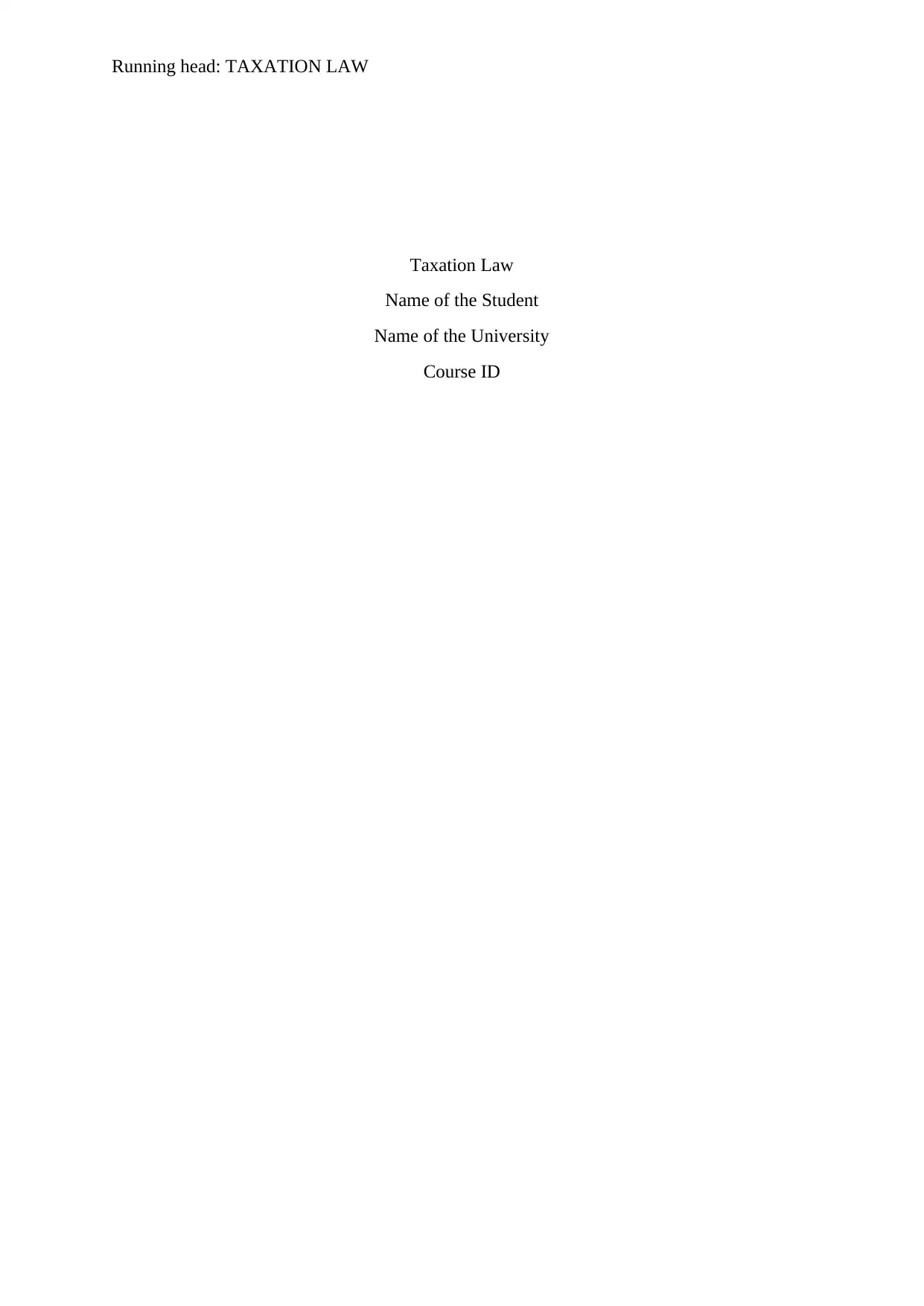
Running head: TAXATION LAW
Taxation Law
Name of the Student
Name of the University
Course ID
Taxation Law
Name of the Student
Name of the University
Course ID
Paraphrase This Document
Need a fresh take? Get an instant paraphrase of this document with our AI Paraphraser
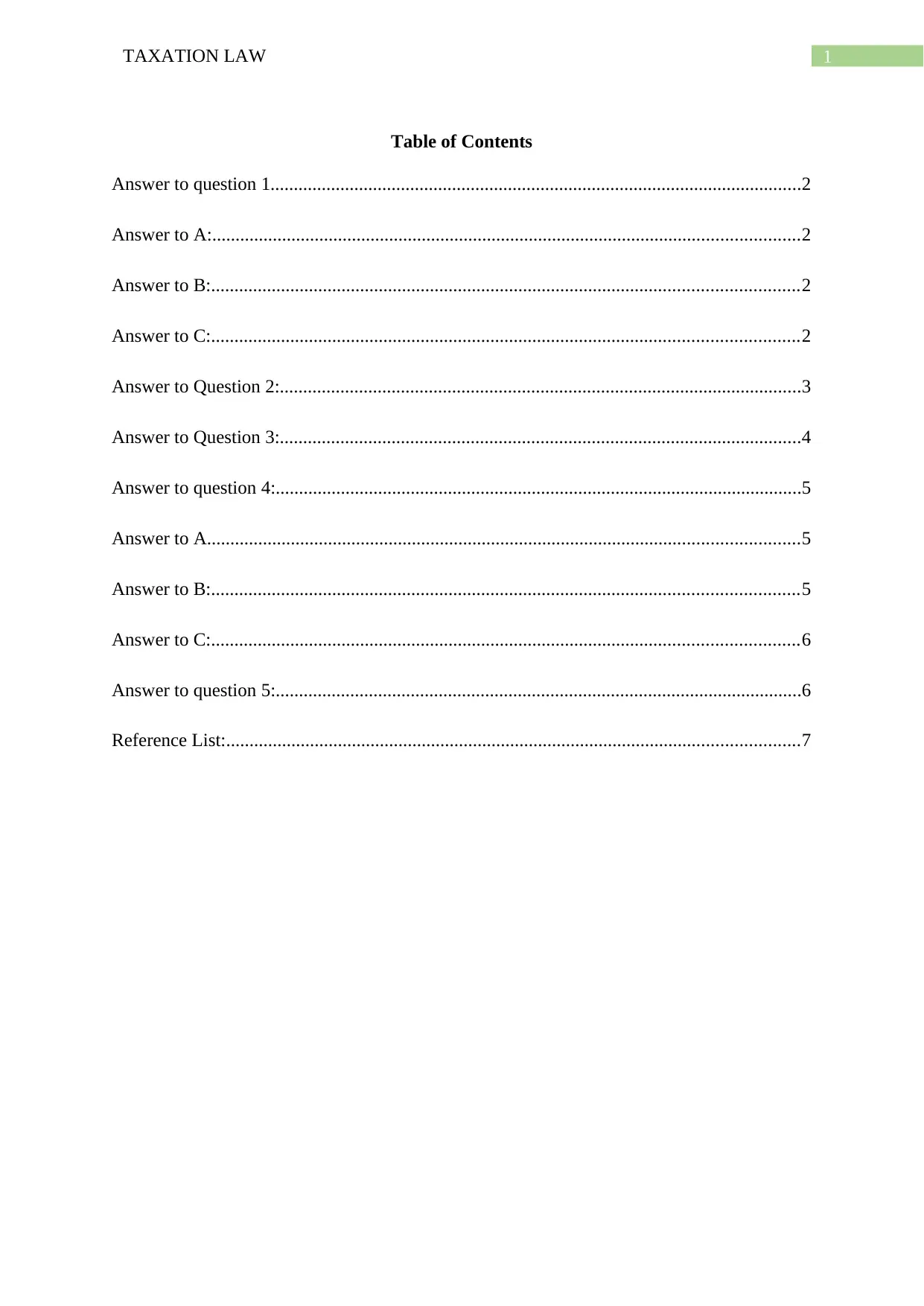
1TAXATION LAW
Table of Contents
Answer to question 1..................................................................................................................2
Answer to A:..............................................................................................................................2
Answer to B:..............................................................................................................................2
Answer to C:..............................................................................................................................2
Answer to Question 2:................................................................................................................3
Answer to Question 3:................................................................................................................4
Answer to question 4:.................................................................................................................5
Answer to A...............................................................................................................................5
Answer to B:..............................................................................................................................5
Answer to C:..............................................................................................................................6
Answer to question 5:.................................................................................................................6
Reference List:...........................................................................................................................7
Table of Contents
Answer to question 1..................................................................................................................2
Answer to A:..............................................................................................................................2
Answer to B:..............................................................................................................................2
Answer to C:..............................................................................................................................2
Answer to Question 2:................................................................................................................3
Answer to Question 3:................................................................................................................4
Answer to question 4:.................................................................................................................5
Answer to A...............................................................................................................................5
Answer to B:..............................................................................................................................5
Answer to C:..............................................................................................................................6
Answer to question 5:.................................................................................................................6
Reference List:...........................................................................................................................7
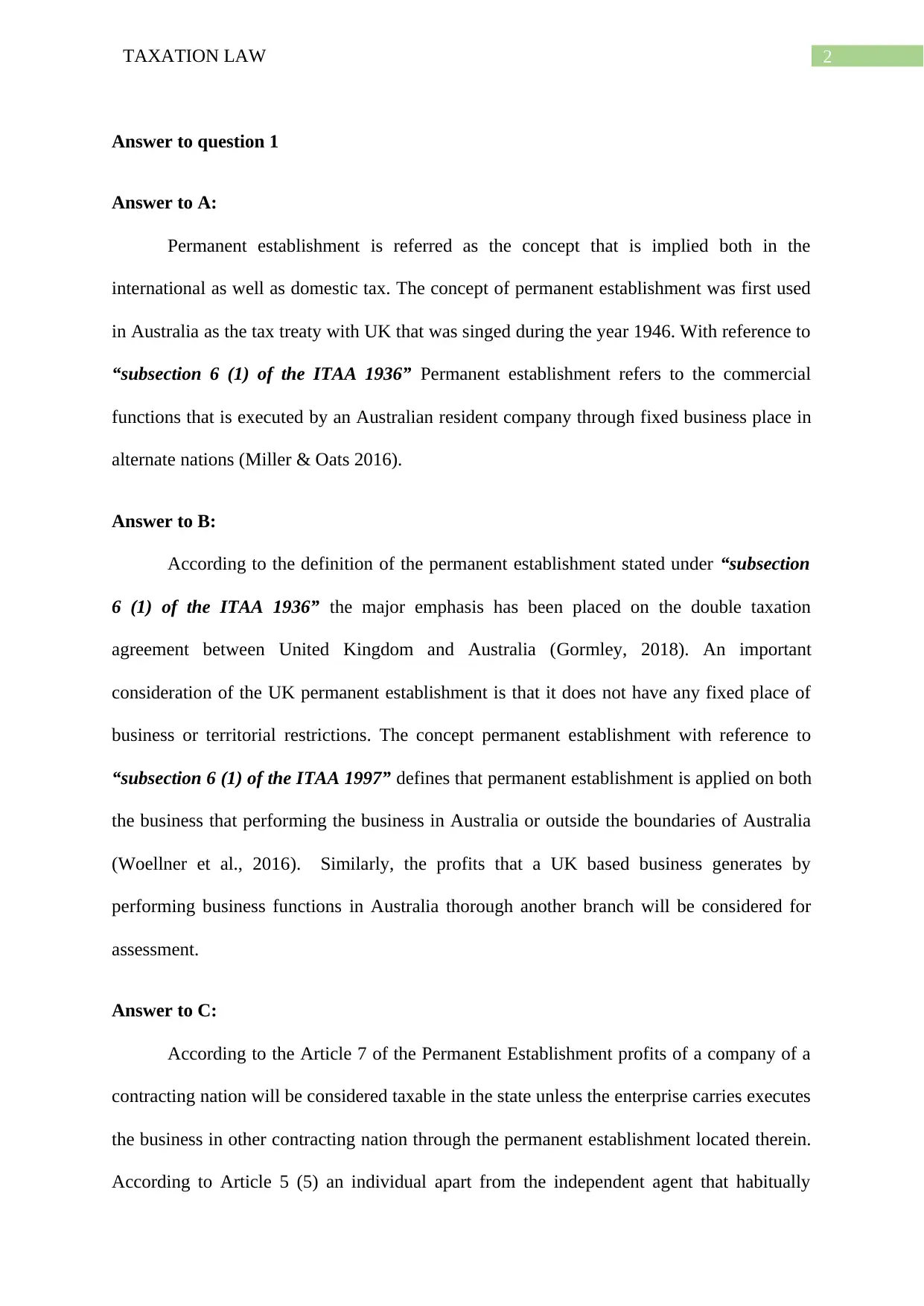
2TAXATION LAW
Answer to question 1
Answer to A:
Permanent establishment is referred as the concept that is implied both in the
international as well as domestic tax. The concept of permanent establishment was first used
in Australia as the tax treaty with UK that was singed during the year 1946. With reference to
“subsection 6 (1) of the ITAA 1936” Permanent establishment refers to the commercial
functions that is executed by an Australian resident company through fixed business place in
alternate nations (Miller & Oats 2016).
Answer to B:
According to the definition of the permanent establishment stated under “subsection
6 (1) of the ITAA 1936” the major emphasis has been placed on the double taxation
agreement between United Kingdom and Australia (Gormley, 2018). An important
consideration of the UK permanent establishment is that it does not have any fixed place of
business or territorial restrictions. The concept permanent establishment with reference to
“subsection 6 (1) of the ITAA 1997” defines that permanent establishment is applied on both
the business that performing the business in Australia or outside the boundaries of Australia
(Woellner et al., 2016). Similarly, the profits that a UK based business generates by
performing business functions in Australia thorough another branch will be considered for
assessment.
Answer to C:
According to the Article 7 of the Permanent Establishment profits of a company of a
contracting nation will be considered taxable in the state unless the enterprise carries executes
the business in other contracting nation through the permanent establishment located therein.
According to Article 5 (5) an individual apart from the independent agent that habitually
Answer to question 1
Answer to A:
Permanent establishment is referred as the concept that is implied both in the
international as well as domestic tax. The concept of permanent establishment was first used
in Australia as the tax treaty with UK that was singed during the year 1946. With reference to
“subsection 6 (1) of the ITAA 1936” Permanent establishment refers to the commercial
functions that is executed by an Australian resident company through fixed business place in
alternate nations (Miller & Oats 2016).
Answer to B:
According to the definition of the permanent establishment stated under “subsection
6 (1) of the ITAA 1936” the major emphasis has been placed on the double taxation
agreement between United Kingdom and Australia (Gormley, 2018). An important
consideration of the UK permanent establishment is that it does not have any fixed place of
business or territorial restrictions. The concept permanent establishment with reference to
“subsection 6 (1) of the ITAA 1997” defines that permanent establishment is applied on both
the business that performing the business in Australia or outside the boundaries of Australia
(Woellner et al., 2016). Similarly, the profits that a UK based business generates by
performing business functions in Australia thorough another branch will be considered for
assessment.
Answer to C:
According to the Article 7 of the Permanent Establishment profits of a company of a
contracting nation will be considered taxable in the state unless the enterprise carries executes
the business in other contracting nation through the permanent establishment located therein.
According to Article 5 (5) an individual apart from the independent agent that habitually
⊘ This is a preview!⊘
Do you want full access?
Subscribe today to unlock all pages.

Trusted by 1+ million students worldwide
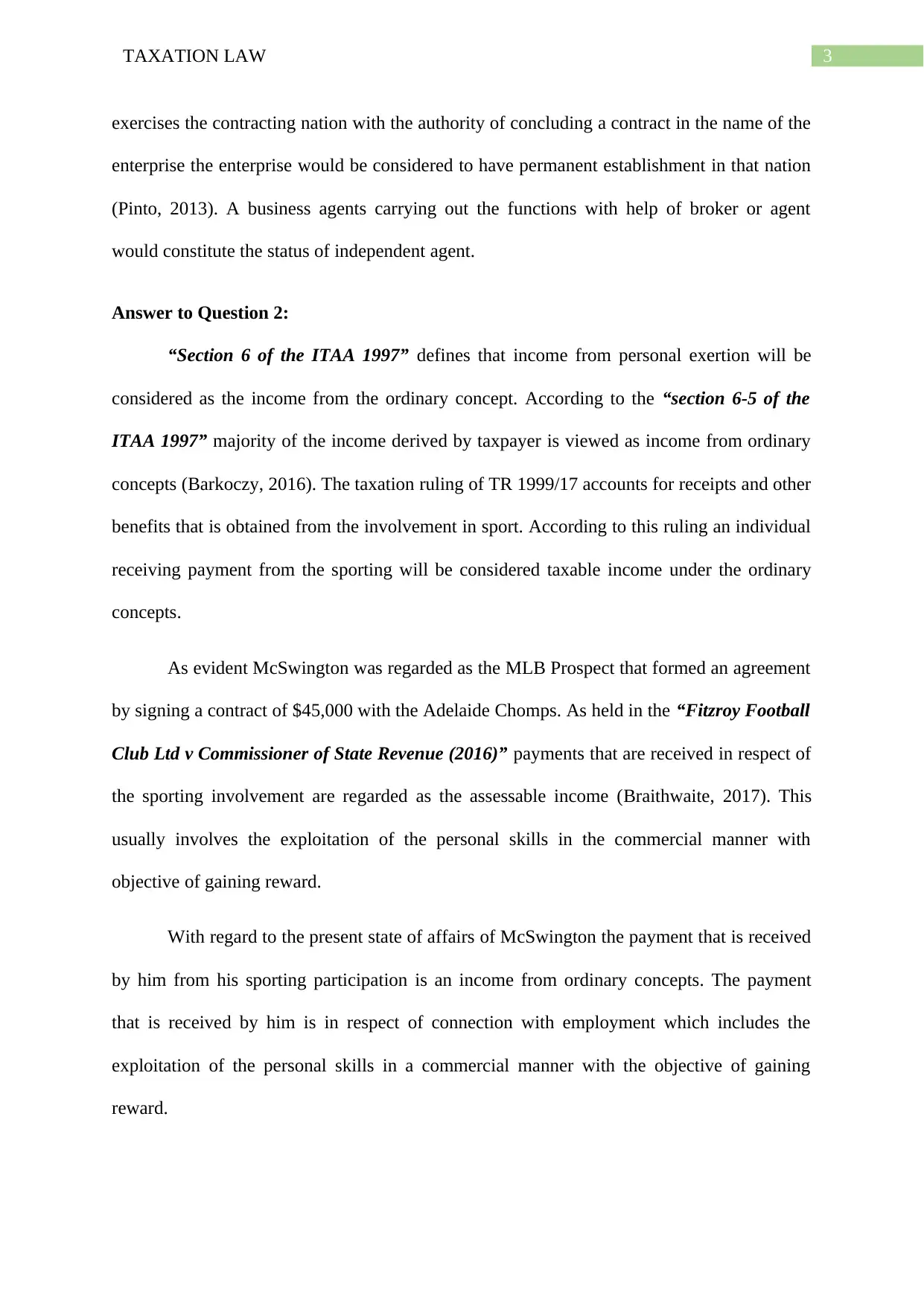
3TAXATION LAW
exercises the contracting nation with the authority of concluding a contract in the name of the
enterprise the enterprise would be considered to have permanent establishment in that nation
(Pinto, 2013). A business agents carrying out the functions with help of broker or agent
would constitute the status of independent agent.
Answer to Question 2:
“Section 6 of the ITAA 1997” defines that income from personal exertion will be
considered as the income from the ordinary concept. According to the “section 6-5 of the
ITAA 1997” majority of the income derived by taxpayer is viewed as income from ordinary
concepts (Barkoczy, 2016). The taxation ruling of TR 1999/17 accounts for receipts and other
benefits that is obtained from the involvement in sport. According to this ruling an individual
receiving payment from the sporting will be considered taxable income under the ordinary
concepts.
As evident McSwington was regarded as the MLB Prospect that formed an agreement
by signing a contract of $45,000 with the Adelaide Chomps. As held in the “Fitzroy Football
Club Ltd v Commissioner of State Revenue (2016)” payments that are received in respect of
the sporting involvement are regarded as the assessable income (Braithwaite, 2017). This
usually involves the exploitation of the personal skills in the commercial manner with
objective of gaining reward.
With regard to the present state of affairs of McSwington the payment that is received
by him from his sporting participation is an income from ordinary concepts. The payment
that is received by him is in respect of connection with employment which includes the
exploitation of the personal skills in a commercial manner with the objective of gaining
reward.
exercises the contracting nation with the authority of concluding a contract in the name of the
enterprise the enterprise would be considered to have permanent establishment in that nation
(Pinto, 2013). A business agents carrying out the functions with help of broker or agent
would constitute the status of independent agent.
Answer to Question 2:
“Section 6 of the ITAA 1997” defines that income from personal exertion will be
considered as the income from the ordinary concept. According to the “section 6-5 of the
ITAA 1997” majority of the income derived by taxpayer is viewed as income from ordinary
concepts (Barkoczy, 2016). The taxation ruling of TR 1999/17 accounts for receipts and other
benefits that is obtained from the involvement in sport. According to this ruling an individual
receiving payment from the sporting will be considered taxable income under the ordinary
concepts.
As evident McSwington was regarded as the MLB Prospect that formed an agreement
by signing a contract of $45,000 with the Adelaide Chomps. As held in the “Fitzroy Football
Club Ltd v Commissioner of State Revenue (2016)” payments that are received in respect of
the sporting involvement are regarded as the assessable income (Braithwaite, 2017). This
usually involves the exploitation of the personal skills in the commercial manner with
objective of gaining reward.
With regard to the present state of affairs of McSwington the payment that is received
by him from his sporting participation is an income from ordinary concepts. The payment
that is received by him is in respect of connection with employment which includes the
exploitation of the personal skills in a commercial manner with the objective of gaining
reward.
Paraphrase This Document
Need a fresh take? Get an instant paraphrase of this document with our AI Paraphraser
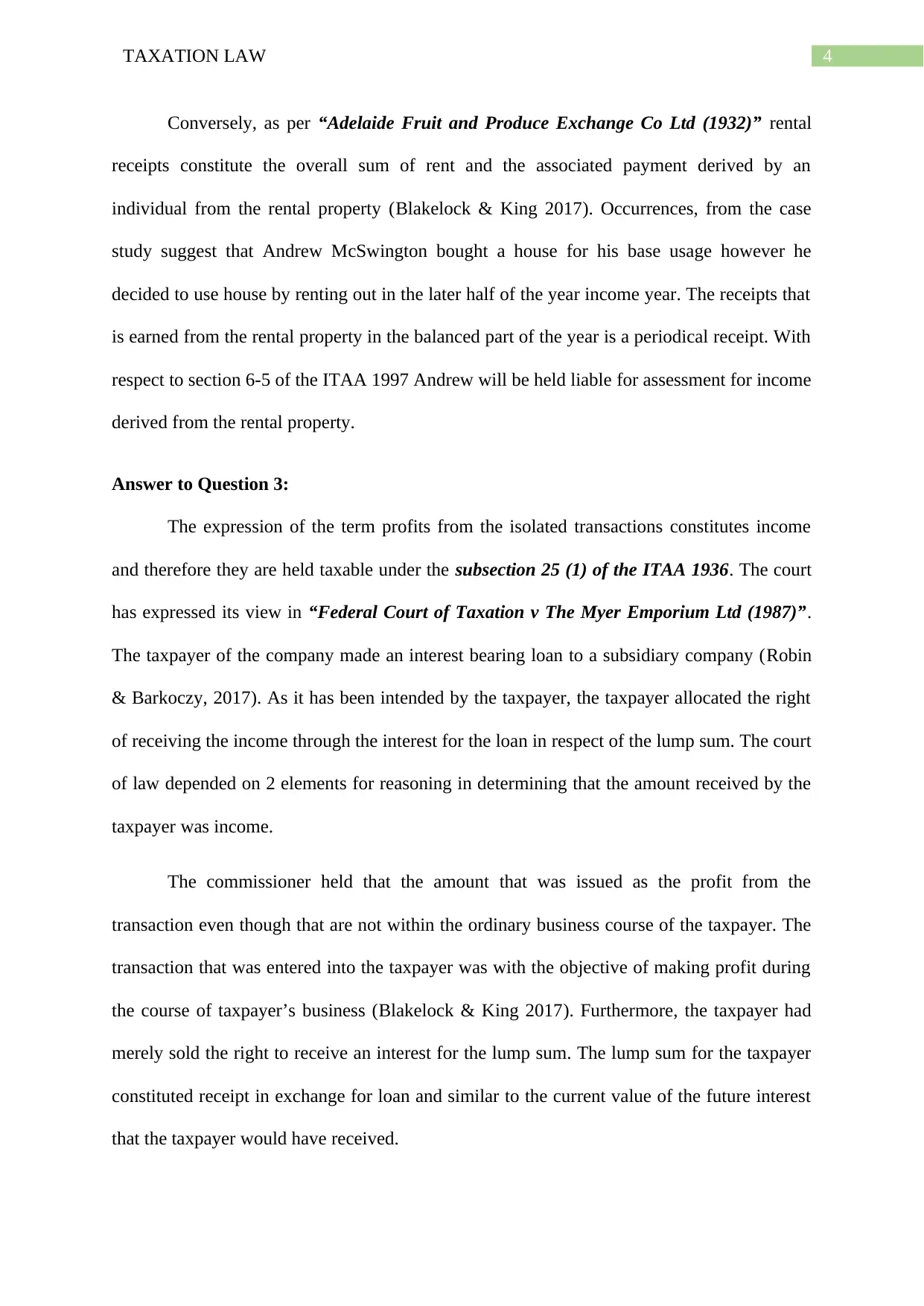
4TAXATION LAW
Conversely, as per “Adelaide Fruit and Produce Exchange Co Ltd (1932)” rental
receipts constitute the overall sum of rent and the associated payment derived by an
individual from the rental property (Blakelock & King 2017). Occurrences, from the case
study suggest that Andrew McSwington bought a house for his base usage however he
decided to use house by renting out in the later half of the year income year. The receipts that
is earned from the rental property in the balanced part of the year is a periodical receipt. With
respect to section 6-5 of the ITAA 1997 Andrew will be held liable for assessment for income
derived from the rental property.
Answer to Question 3:
The expression of the term profits from the isolated transactions constitutes income
and therefore they are held taxable under the subsection 25 (1) of the ITAA 1936. The court
has expressed its view in “Federal Court of Taxation v The Myer Emporium Ltd (1987)”.
The taxpayer of the company made an interest bearing loan to a subsidiary company (Robin
& Barkoczy, 2017). As it has been intended by the taxpayer, the taxpayer allocated the right
of receiving the income through the interest for the loan in respect of the lump sum. The court
of law depended on 2 elements for reasoning in determining that the amount received by the
taxpayer was income.
The commissioner held that the amount that was issued as the profit from the
transaction even though that are not within the ordinary business course of the taxpayer. The
transaction that was entered into the taxpayer was with the objective of making profit during
the course of taxpayer’s business (Blakelock & King 2017). Furthermore, the taxpayer had
merely sold the right to receive an interest for the lump sum. The lump sum for the taxpayer
constituted receipt in exchange for loan and similar to the current value of the future interest
that the taxpayer would have received.
Conversely, as per “Adelaide Fruit and Produce Exchange Co Ltd (1932)” rental
receipts constitute the overall sum of rent and the associated payment derived by an
individual from the rental property (Blakelock & King 2017). Occurrences, from the case
study suggest that Andrew McSwington bought a house for his base usage however he
decided to use house by renting out in the later half of the year income year. The receipts that
is earned from the rental property in the balanced part of the year is a periodical receipt. With
respect to section 6-5 of the ITAA 1997 Andrew will be held liable for assessment for income
derived from the rental property.
Answer to Question 3:
The expression of the term profits from the isolated transactions constitutes income
and therefore they are held taxable under the subsection 25 (1) of the ITAA 1936. The court
has expressed its view in “Federal Court of Taxation v The Myer Emporium Ltd (1987)”.
The taxpayer of the company made an interest bearing loan to a subsidiary company (Robin
& Barkoczy, 2017). As it has been intended by the taxpayer, the taxpayer allocated the right
of receiving the income through the interest for the loan in respect of the lump sum. The court
of law depended on 2 elements for reasoning in determining that the amount received by the
taxpayer was income.
The commissioner held that the amount that was issued as the profit from the
transaction even though that are not within the ordinary business course of the taxpayer. The
transaction that was entered into the taxpayer was with the objective of making profit during
the course of taxpayer’s business (Blakelock & King 2017). Furthermore, the taxpayer had
merely sold the right to receive an interest for the lump sum. The lump sum for the taxpayer
constituted receipt in exchange for loan and similar to the current value of the future interest
that the taxpayer would have received.
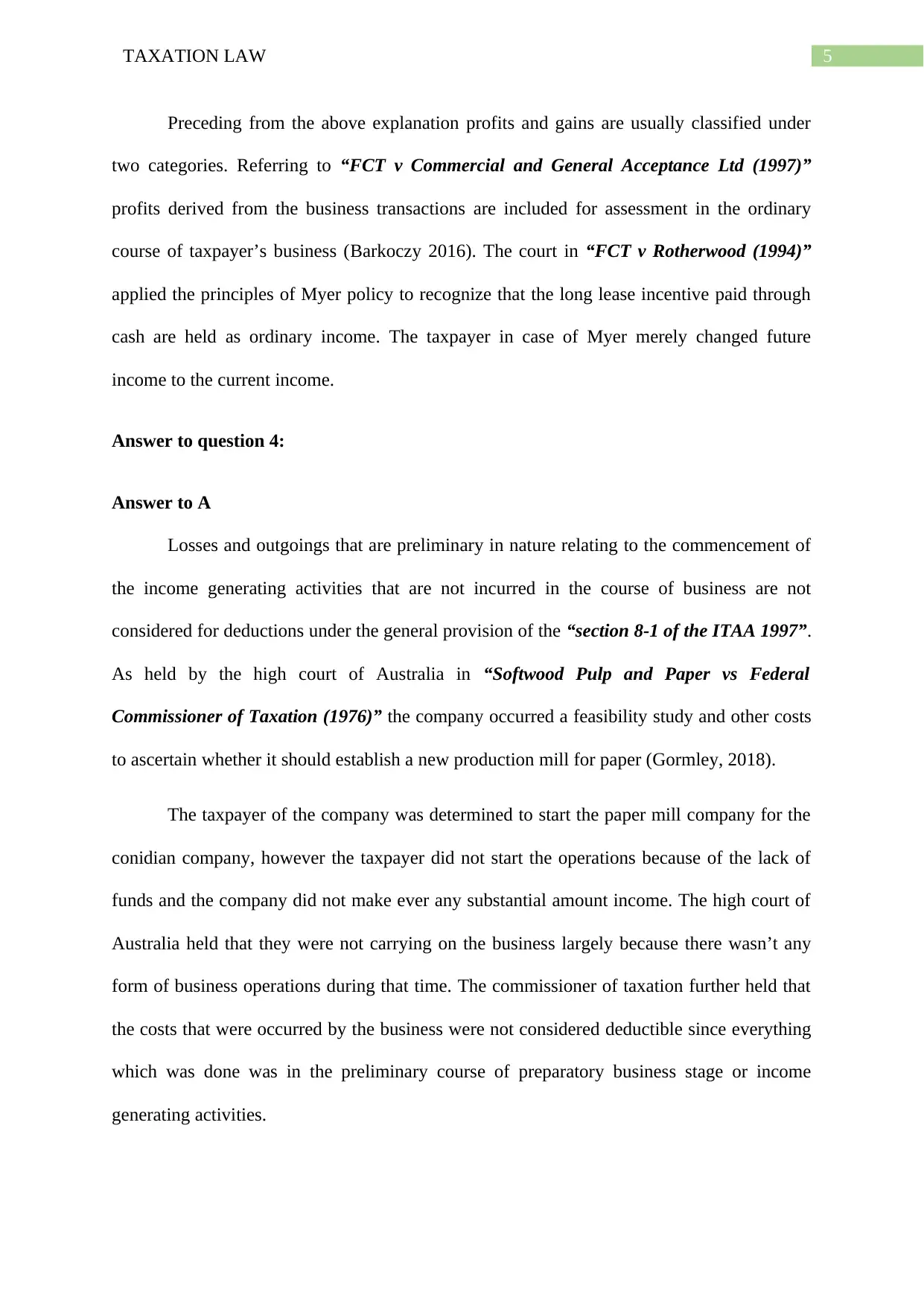
5TAXATION LAW
Preceding from the above explanation profits and gains are usually classified under
two categories. Referring to “FCT v Commercial and General Acceptance Ltd (1997)”
profits derived from the business transactions are included for assessment in the ordinary
course of taxpayer’s business (Barkoczy 2016). The court in “FCT v Rotherwood (1994)”
applied the principles of Myer policy to recognize that the long lease incentive paid through
cash are held as ordinary income. The taxpayer in case of Myer merely changed future
income to the current income.
Answer to question 4:
Answer to A
Losses and outgoings that are preliminary in nature relating to the commencement of
the income generating activities that are not incurred in the course of business are not
considered for deductions under the general provision of the “section 8-1 of the ITAA 1997”.
As held by the high court of Australia in “Softwood Pulp and Paper vs Federal
Commissioner of Taxation (1976)” the company occurred a feasibility study and other costs
to ascertain whether it should establish a new production mill for paper (Gormley, 2018).
The taxpayer of the company was determined to start the paper mill company for the
conidian company, however the taxpayer did not start the operations because of the lack of
funds and the company did not make ever any substantial amount income. The high court of
Australia held that they were not carrying on the business largely because there wasn’t any
form of business operations during that time. The commissioner of taxation further held that
the costs that were occurred by the business were not considered deductible since everything
which was done was in the preliminary course of preparatory business stage or income
generating activities.
Preceding from the above explanation profits and gains are usually classified under
two categories. Referring to “FCT v Commercial and General Acceptance Ltd (1997)”
profits derived from the business transactions are included for assessment in the ordinary
course of taxpayer’s business (Barkoczy 2016). The court in “FCT v Rotherwood (1994)”
applied the principles of Myer policy to recognize that the long lease incentive paid through
cash are held as ordinary income. The taxpayer in case of Myer merely changed future
income to the current income.
Answer to question 4:
Answer to A
Losses and outgoings that are preliminary in nature relating to the commencement of
the income generating activities that are not incurred in the course of business are not
considered for deductions under the general provision of the “section 8-1 of the ITAA 1997”.
As held by the high court of Australia in “Softwood Pulp and Paper vs Federal
Commissioner of Taxation (1976)” the company occurred a feasibility study and other costs
to ascertain whether it should establish a new production mill for paper (Gormley, 2018).
The taxpayer of the company was determined to start the paper mill company for the
conidian company, however the taxpayer did not start the operations because of the lack of
funds and the company did not make ever any substantial amount income. The high court of
Australia held that they were not carrying on the business largely because there wasn’t any
form of business operations during that time. The commissioner of taxation further held that
the costs that were occurred by the business were not considered deductible since everything
which was done was in the preliminary course of preparatory business stage or income
generating activities.
⊘ This is a preview!⊘
Do you want full access?
Subscribe today to unlock all pages.

Trusted by 1+ million students worldwide
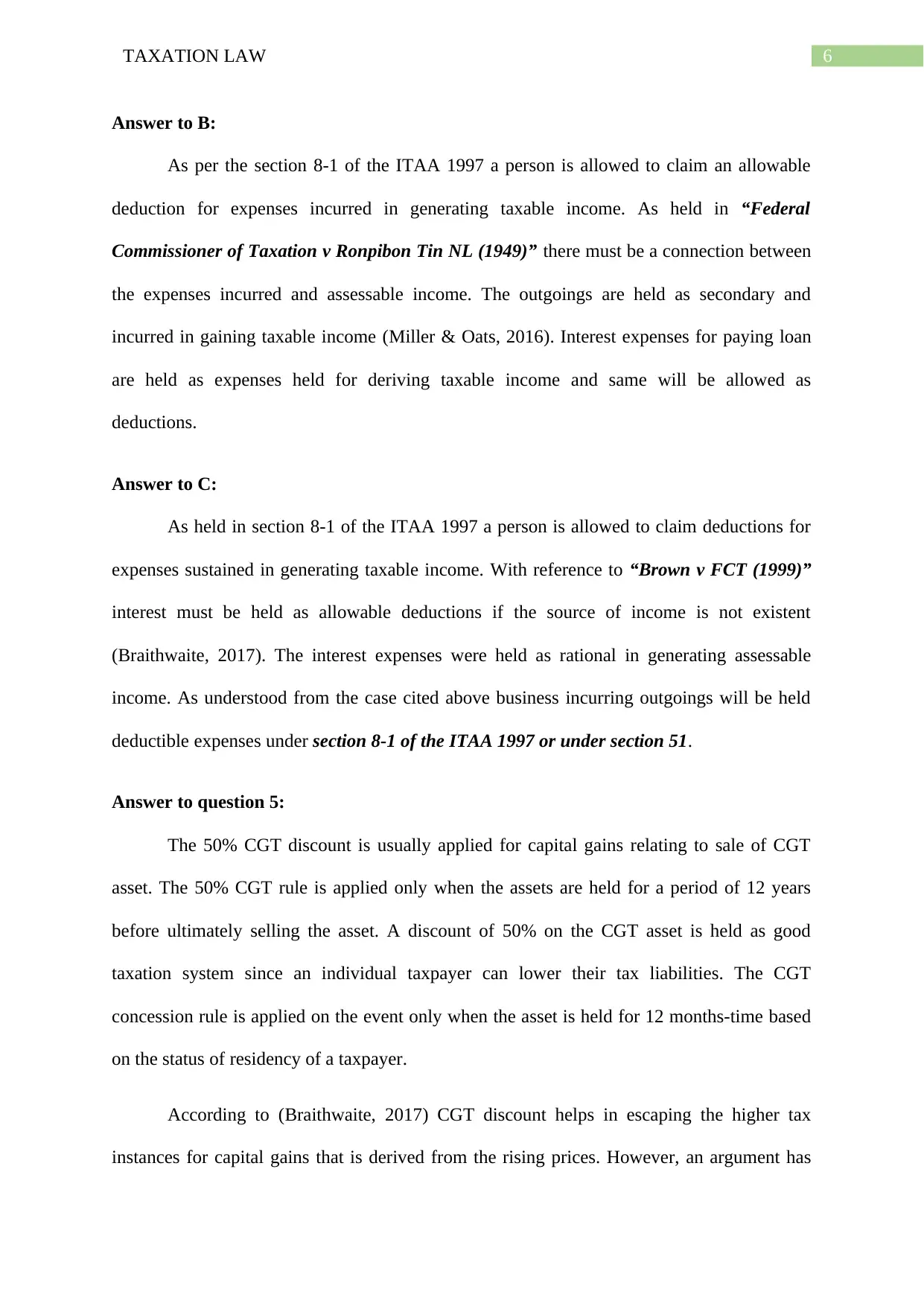
6TAXATION LAW
Answer to B:
As per the section 8-1 of the ITAA 1997 a person is allowed to claim an allowable
deduction for expenses incurred in generating taxable income. As held in “Federal
Commissioner of Taxation v Ronpibon Tin NL (1949)” there must be a connection between
the expenses incurred and assessable income. The outgoings are held as secondary and
incurred in gaining taxable income (Miller & Oats, 2016). Interest expenses for paying loan
are held as expenses held for deriving taxable income and same will be allowed as
deductions.
Answer to C:
As held in section 8-1 of the ITAA 1997 a person is allowed to claim deductions for
expenses sustained in generating taxable income. With reference to “Brown v FCT (1999)”
interest must be held as allowable deductions if the source of income is not existent
(Braithwaite, 2017). The interest expenses were held as rational in generating assessable
income. As understood from the case cited above business incurring outgoings will be held
deductible expenses under section 8-1 of the ITAA 1997 or under section 51.
Answer to question 5:
The 50% CGT discount is usually applied for capital gains relating to sale of CGT
asset. The 50% CGT rule is applied only when the assets are held for a period of 12 years
before ultimately selling the asset. A discount of 50% on the CGT asset is held as good
taxation system since an individual taxpayer can lower their tax liabilities. The CGT
concession rule is applied on the event only when the asset is held for 12 months-time based
on the status of residency of a taxpayer.
According to (Braithwaite, 2017) CGT discount helps in escaping the higher tax
instances for capital gains that is derived from the rising prices. However, an argument has
Answer to B:
As per the section 8-1 of the ITAA 1997 a person is allowed to claim an allowable
deduction for expenses incurred in generating taxable income. As held in “Federal
Commissioner of Taxation v Ronpibon Tin NL (1949)” there must be a connection between
the expenses incurred and assessable income. The outgoings are held as secondary and
incurred in gaining taxable income (Miller & Oats, 2016). Interest expenses for paying loan
are held as expenses held for deriving taxable income and same will be allowed as
deductions.
Answer to C:
As held in section 8-1 of the ITAA 1997 a person is allowed to claim deductions for
expenses sustained in generating taxable income. With reference to “Brown v FCT (1999)”
interest must be held as allowable deductions if the source of income is not existent
(Braithwaite, 2017). The interest expenses were held as rational in generating assessable
income. As understood from the case cited above business incurring outgoings will be held
deductible expenses under section 8-1 of the ITAA 1997 or under section 51.
Answer to question 5:
The 50% CGT discount is usually applied for capital gains relating to sale of CGT
asset. The 50% CGT rule is applied only when the assets are held for a period of 12 years
before ultimately selling the asset. A discount of 50% on the CGT asset is held as good
taxation system since an individual taxpayer can lower their tax liabilities. The CGT
concession rule is applied on the event only when the asset is held for 12 months-time based
on the status of residency of a taxpayer.
According to (Braithwaite, 2017) CGT discount helps in escaping the higher tax
instances for capital gains that is derived from the rising prices. However, an argument has
Paraphrase This Document
Need a fresh take? Get an instant paraphrase of this document with our AI Paraphraser
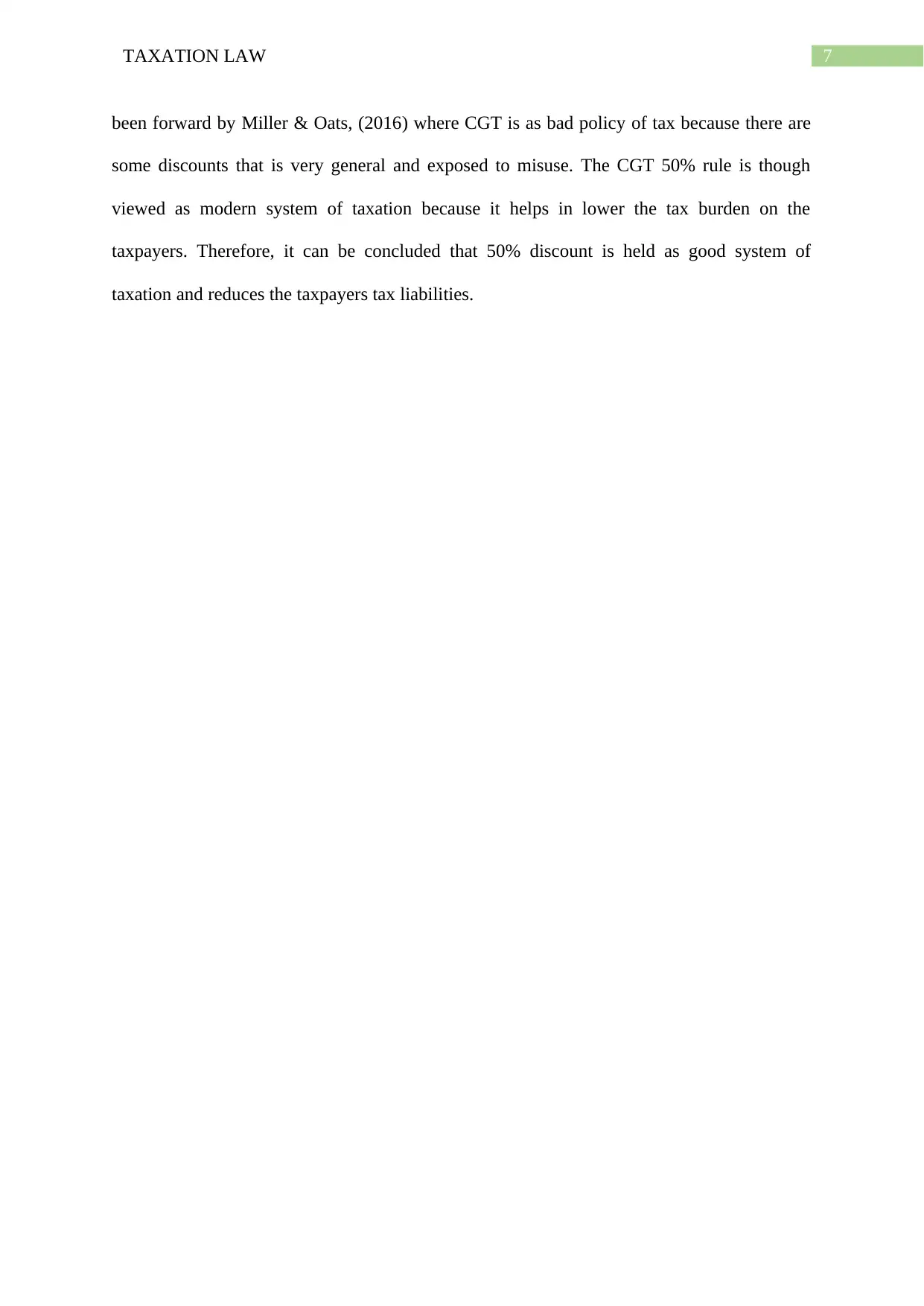
7TAXATION LAW
been forward by Miller & Oats, (2016) where CGT is as bad policy of tax because there are
some discounts that is very general and exposed to misuse. The CGT 50% rule is though
viewed as modern system of taxation because it helps in lower the tax burden on the
taxpayers. Therefore, it can be concluded that 50% discount is held as good system of
taxation and reduces the taxpayers tax liabilities.
been forward by Miller & Oats, (2016) where CGT is as bad policy of tax because there are
some discounts that is very general and exposed to misuse. The CGT 50% rule is though
viewed as modern system of taxation because it helps in lower the tax burden on the
taxpayers. Therefore, it can be concluded that 50% discount is held as good system of
taxation and reduces the taxpayers tax liabilities.
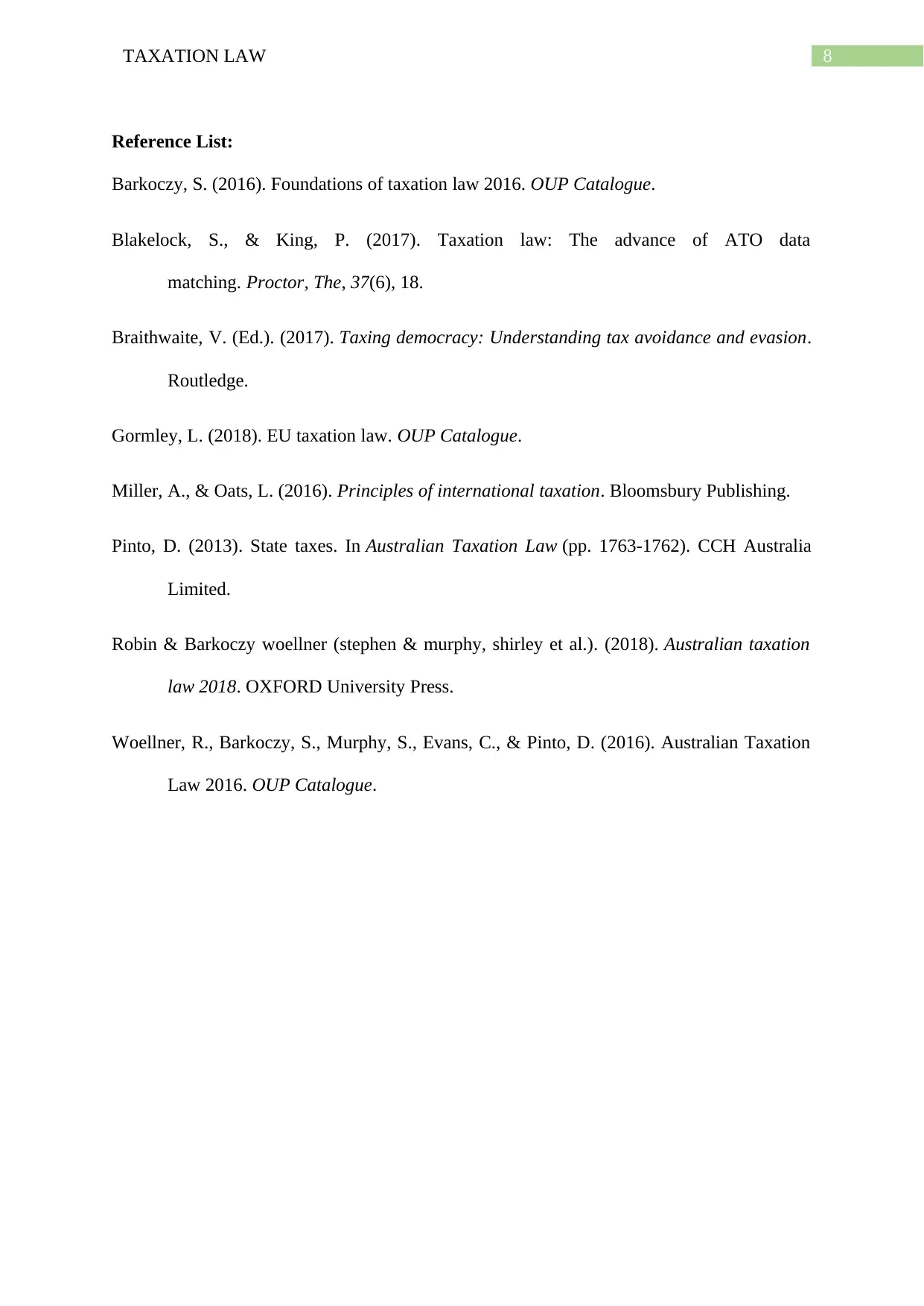
8TAXATION LAW
Reference List:
Barkoczy, S. (2016). Foundations of taxation law 2016. OUP Catalogue.
Blakelock, S., & King, P. (2017). Taxation law: The advance of ATO data
matching. Proctor, The, 37(6), 18.
Braithwaite, V. (Ed.). (2017). Taxing democracy: Understanding tax avoidance and evasion.
Routledge.
Gormley, L. (2018). EU taxation law. OUP Catalogue.
Miller, A., & Oats, L. (2016). Principles of international taxation. Bloomsbury Publishing.
Pinto, D. (2013). State taxes. In Australian Taxation Law (pp. 1763-1762). CCH Australia
Limited.
Robin & Barkoczy woellner (stephen & murphy, shirley et al.). (2018). Australian taxation
law 2018. OXFORD University Press.
Woellner, R., Barkoczy, S., Murphy, S., Evans, C., & Pinto, D. (2016). Australian Taxation
Law 2016. OUP Catalogue.
Reference List:
Barkoczy, S. (2016). Foundations of taxation law 2016. OUP Catalogue.
Blakelock, S., & King, P. (2017). Taxation law: The advance of ATO data
matching. Proctor, The, 37(6), 18.
Braithwaite, V. (Ed.). (2017). Taxing democracy: Understanding tax avoidance and evasion.
Routledge.
Gormley, L. (2018). EU taxation law. OUP Catalogue.
Miller, A., & Oats, L. (2016). Principles of international taxation. Bloomsbury Publishing.
Pinto, D. (2013). State taxes. In Australian Taxation Law (pp. 1763-1762). CCH Australia
Limited.
Robin & Barkoczy woellner (stephen & murphy, shirley et al.). (2018). Australian taxation
law 2018. OXFORD University Press.
Woellner, R., Barkoczy, S., Murphy, S., Evans, C., & Pinto, D. (2016). Australian Taxation
Law 2016. OUP Catalogue.
⊘ This is a preview!⊘
Do you want full access?
Subscribe today to unlock all pages.

Trusted by 1+ million students worldwide
1 out of 9
Related Documents
Your All-in-One AI-Powered Toolkit for Academic Success.
+13062052269
info@desklib.com
Available 24*7 on WhatsApp / Email
![[object Object]](/_next/static/media/star-bottom.7253800d.svg)
Unlock your academic potential
Copyright © 2020–2025 A2Z Services. All Rights Reserved. Developed and managed by ZUCOL.



